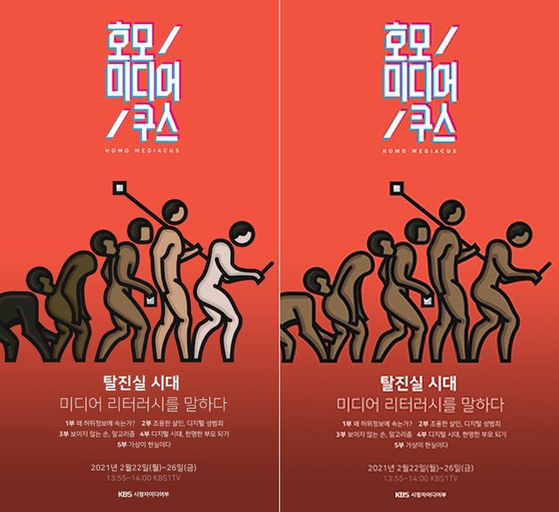![KBS revised the poster of the special documentary'Homo Mediacus' to point out racism. Right after this correction. [KBS 제공]](https://i0.wp.com/pds.joins.com/news/component/htmlphoto_mmdata/202102/20/3041732a-faea-4e72-9c31-96a00e8f312e.jpg?w=560&ssl=1)
KBS revised the poster of the special documentary’Homo Mediacus’ to point out racism. Right after this correction. [KBS 제공]
KBS, a public broadcaster who was in trouble with the controversy over Japanese colors, stood at the center of the controversy this time with a poster containing racist content. On the 18th, KBS unveiled a poster for’Homo Mediacus’, a five-part documentary that deals with false information, digital sex crimes, SNS algorithms, digital parenting, and virtual reality.
The poster depicts the rapidly changing humanity according to the media environment, but the problem was raised as the skin color changed from colored to white as it evolved from an ape to a human.
“Did your skin color become white as humanity evolved?” said Park Sang-hyun, who is active as a columnist, on Facebook. He pointed out that the racist image that he created moves around.”
“Even if the designer made it without much thought, at least a few people seem to have gone through the steps to confirm and approve the problem, but the fact that no one found the problem means that they are familiar with the racist way of thinking about skin color.” “The exceptionally high Asian thinking seems to have contributed to this discriminatory attitude,” he added.
As criticism spread, KBS redistributed posters in which all five forms of humanity included in the evolutionary stage were modified to the same color. KBS said on the 19th, “The Homo Mediacus poster image sent yesterday (18th) needs correction and will be re-produced.”
Although KBS asked not to use the controversial poster, it did not express an apology for the racism controversy or explain the specific production process.
Previously, KBS had aroused controversy over suspicion that it used Japanese architecture as the stage background in the program’Chosun Pop Again’, which was broadcasted on the 11th Lunar New Year special. KBS explained through the statement on the 18th that it was “an image that represents the dragon palace in the imagination,” and that “we created it by referring to various references and animations to implement the dragon palace.”
In addition, the same problem was pointed out in the KBS 1TV New Year special’Singing Korean Traditional Music Songs’, which aired on the same day. Accordingly, KBS said, “Like’Chosun Pop Again’, it is an expression of Yonggung, and it is not intentional copying of Japanese castle.”
Reporter Jeong Hye-jeong [email protected]
